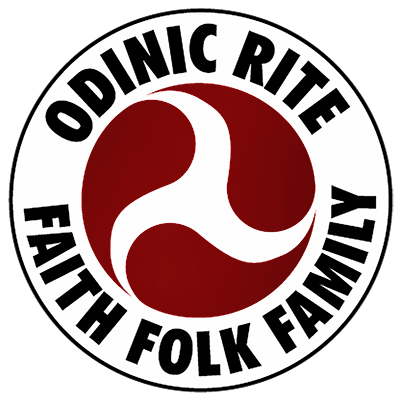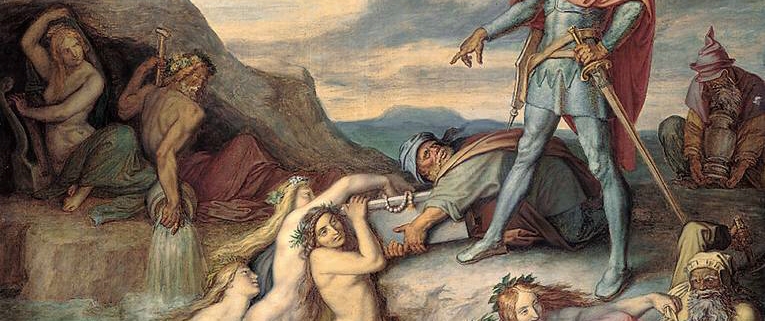The Burgundians
by Hariulf OR
In this short article I will talk about a little known Germanic people: the Burgundians. The Burgundians have played an important role in what became the modern Switzerland. Indeed the part of the Swiss settled by the Burgundians became the “Suisse Romande” (French speaking part of Switzerland). The German part of Switzerland was settled by another Germanic tribe, the Alamanni.
The Burgundians were an East Germanic tribe. They probably are originated from Norway or from the island of Bornholm (Burgundarholm) in the Baltic. The name of this island means “island of the Burgundians”. The Burgundians are listed for the first time by Pliny the Elder (AD 23 – August 25, 79), who saw in them a tribe of the Vandal nation. In the second half of the second century, Ptolemy cites them as the neighbours of eastern Semnones.
The early period (before 436 CE) and the first Burgundian Kingdom
The migratory waves triggered by the Goths (The Barbarian Invasions) led division of the Burgundian people to the edge of the Black Sea, while the bulk of the population stood on the left bank of the middle course of the Oder. In the 270s CE, the Burgundian came first in contact with the Romans. By the late third century, a sufficiently numerous Burgundian population took possession of the territories of the Rhine and Main abandoned by the Alamanni after they had forced the “lime” in 259/260. The Burgundians sought to ally themselves with Rome against the Alamanni, but the campaign planned to the years 369/370 failed because the Romans saw a threat in the arrival of Burgundian warriors in unexpected numbers.
At the end of the fourth century, the Burgundians drove out the Alamanni in the region between the Taunus and the Neckar River and reached the Rhine, the bulk of its population crossed in 406/407, after the Vandals, the Swabians and the Alani. The Burgundians, at the orders of their leader Gondichaire (Gundahar, Gunther) ensured the protection of the Rhine frontier as a federated nation to the Romans. In 411 CE the Burgundians brought their support to the uprising of Jovin in the province of “Germania Inferior” and escorted him to southern Gaul.
After Jovinus death in 413, they received as Federated a “part of Gaul near the Rhine”: the first Burgundian kingdom should probably be located on the middle of the Rhine near Worms.
Around the year 430, the Burgundians who lived on the right bank of the Rhine won a victory over a detachment of Hun, but shortly after they fell under the domination of this Asian people from whom they borrowed the custom of skull deformation.
In 436, the Huns, probably allied to Aetius, brought the downfall of the kingdom of Burgundy in the Rhine. Gundahar was killed in this fighting, reportedly along with the majority of the Burgundian tribe. The destruction of Worms and of the Burgundian kingdom by the Huns became the subject of heroic legends (Völsunga saga, Atlakviða) that were afterwards incorporated in the Nibelungenlied where King Gunther (Gundahar) and Queen Brünhild hold their court at Worms, and Siegfried comes to woo Kriemhild. (In Old Norse sources the names are Gunnar, Brynhild, and Gudrún as normally rendered in English.) In fact, Etzel of the Nibelungenlied is based on Attila the Hun.
The Second Burgundian Kingdom – The settlement in Sapaudia
In 443, Aetius establishes the survivors of the Burgundian people in Sapaudia. This name survives in that of the modern Savoy but means yet another geographical reality: recent research defining an area between the Ain, Rhône, Geneva, Jura and the Aar (southern part of the Maxima Sequanorum), or a territory extending into the basin of the Aar and the Rhine (cities of Geneva, Nyon and Avenches). Aetius wanted to at least slow the advance of the Alamanni on the Central Plateau to ensure the route of the Alpine passes and the Rhine-Rhone. He also wanted to create a reserve for fighting in Gaul.
Already in 451, the Burgundians had to fight the Huns at the Battle of Chalons (the Battle of the Catalaunian Plains). In 456, under the leadership of their kings Gondioc and Chilperic they brought their support to the Emperor Avitus in his fight against the Suebi in Spain.
In 457, the territory under their rule extended to the south-west towards the Saone-Rhone region and they finally occupied Lyon in 461. After the death of Gondioc in 470, Chilperic continued the expansion southward. In 478, an agreement with the Visigoths fixed the border on the Durance River.
In the north, Chilperic drove the Alemanni from Langres and Besancon. At his death in 480, the Burgundian kingdom reached its greatest extent. When sharing between his four sons, Gondebald (Gondebaud) received the principal royalty with Lyon for capital, while Godegisel, Chilperic II and Gondomar inherited the secondary royalty and established respectively themselves in Geneva, Vienne and probably Valence.
At the end of the fifth century, the Burgundians suffered increasing pressure from the Franks to the north and from the Ostrogoths and the Visigoths to the south. Gondebald sought to protect himself and to form alliances with two marriages : his son Sigismund (Sigismond) married Ariagne, the daughter of Theodoric the Great, king of the Ostrogoths in 492/494, while Clotilde, daughter of Chilperic II was married to Clovis I, King of the Franks in 492/493.
But in 500, during the conflict between the kings of Lyon and Geneva, the Franks stuck up for Godegisel and the Visigoths stuck up for Gondebald. Despite his victory near Dijon (500) Godégisel eventually had to submit to Gondebald, who regained his kingdom with the aid of the Visigoths. Then in 506/507 Gondebald concluded an alliance with Clovis, his former adversary, against the Alemanni and the Visigoths protected by Theodoric the Great.
The fall of the second Burgundian kingdom (532-534)
At Gondebald’s death in 516 his eldest son, Sigismund, succeeded him. The conversion of Sigismund from Arianism to Catholicism, between 501/502 and 507 contributed to tensions with the Ostrogoths. This context explains the assassination in 522, by Sigismund of his own son Segeric, grandson of Theodoric the Great, who was suspected of plotting with his grandfather.
The kings of the Franks took advantage of this pretext to conquer the northern kingdom, while in 523; Theodoric occupied the territory between the Durance and the Isere. Captured when he tried to take refuge in the convent of Saint-Maurice (founded by him), Sigismund was delivered to the Franks and killed by King Clodomir.
In 524, Gondomar, meanwhile proclaimed king of the Burgundians, succeeded during the Battle of Vézeronce (east of Vienne) to push back a second attack of the Franks, but he could not resist the third and was defeated in Autun in 532.
This defeat marked the end of the Burgundian Kingdom, which was divided in 534 between the Franks sovereigns: Theodebert king of Reims received the north part (Langres, Besançon, Autun, Chalon, Aventicu-Vindonissa, Octodurus) Childebert King of Paris, the center (Lyon, Macon, Vienne, Grenoble and possibly Geneva and the Tarentaise), and Clotaire, king of Soissons, probably south to the Durance. We therefore speak of Burgundy into the Frankish Kingdom.
The Burgundians and Religion
Prior to their settlement on the Rhine, the Burgundians had not a king but two “Chiefs”, one military and political, the other, religious. In his “Res Gestæ”, Ammianus Marcellinus gives some guidance on the exercise of authority within the Burgundian people. He says that the people were led by a character who bore the generic name “Hendinos”. This “Hendinos” was responsible for the prosperity and success of the people but he could be fired “if good fortune abandoned him at the war or if the harvest is lacking”. They also obey a high priest, elected for life. This high priest was called “Sinistus”. The Burgundians were at that time, pagans. There is no information about the polytheism of the Burgundian.
In 369, the Burgundians changed their religion. They converted to the Arian form of Christianity. They also adopted a hereditary monarchy as the other Germanic peoples. They had to be converted to the Arianism at the time of their arrival on the Main, because they are not far from the Vandals (who were Arians). In 453, when they arrived in the Rhone valley, they were Arians. The Roman Empire took the Catholic doctrine and considered the Germans as heretics. This situation became a source of difficulty. The Burgundians possessed a clergy with monasteries, priests and bishops. Arianism was a way to show their membership in the Burgundian people. However, Gondebald’s son and successor, Sigismund, was himself a Catholic, and there is evidence that many of the Burgundian people had converted by this time as well, including several female members of the ruling family.
Burgundian Laws
The Burgundians left three legal codes, among the earliest from any of the Germanic tribes.
The Liber Constitutionum sive Lex Gundobada (The Book of the Constitution following the Law of Gondebald), also known as the Lex Burgundionum, or more simply the Lex Gundobada, was issued in several parts between 483 and 516, principally by Gondebald, but also by his son, Sigismund.
Like many of the Germanic tribes, the Burgundians legal traditions allowed the application of separate laws for separate ethnicities. Thus, in addition to the Lex Gundobada, Gondebald also issued (or codified) a set of laws for Roman subjects of the Burgundian kingdom, the Lex Romana Burgundionum (The Roman Law of the Burgundians).
The Burgundian Heritage
The name of the Burgundians has since remained connected to an area of modern France that still bears their name: Burgundy. The descendants of the Burgundians today are found primarily among the west Swiss and neighbouring regions of France.
Sources and influences:
– Dictionnaire Historique de la Suisse
– Les Burgondes: Un royaume oublié au coeur de l’Europe By Justin Favrod
– Les Burgondes: Ie-VIe siècle apr. J-C by Katalin Escher








Leave a Reply
Want to join the discussion?Feel free to contribute!